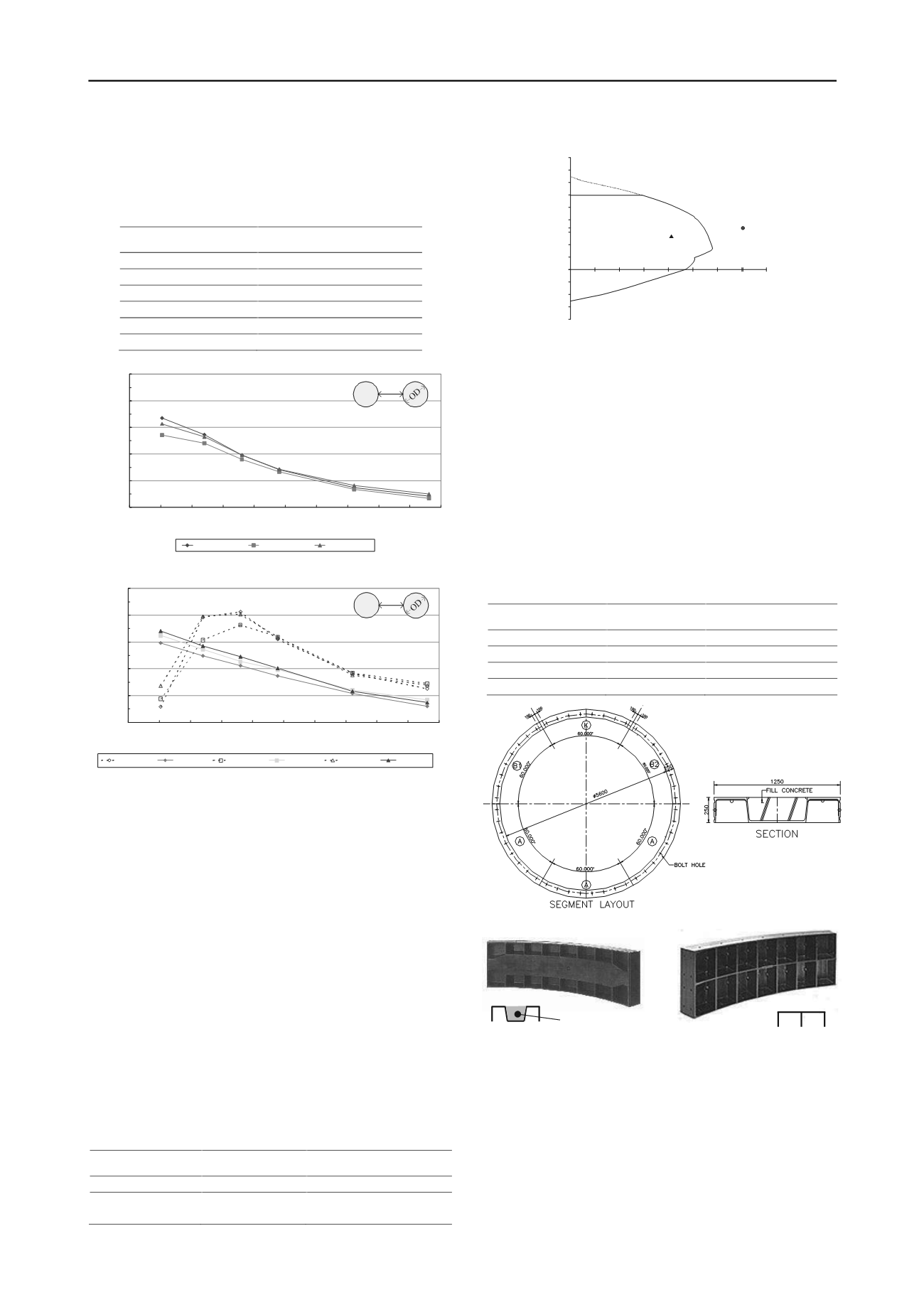
1689
Technical Committee 204 /
Comité technique 204
Proceedings of the 18
th
International Conference on Soil Mechanics and Geotechnical Engineering, Paris 2013
when the tunnel clearance is smaller than 0.8. In addition, the
results indicate a significant difference (about 20%) of stress on
both sides of the tunnel when the tunnel clearance is about 0.2.
Table 1. Suggestion of additional surcharge with respect to tunnel
clearance (after JRCEA 1977)
Tunnel clearance, a
Additional surcharge /
v
’
1.0 < a
0
0.9 < a
≦
1.0
0.1
0.8 < a
≦
0.9
0.2
0.7 < a
≦
0.8
0.3
0.6 < a
≦
0.7
0.4
0.5 < a
≦
0.6
0.5
v
’
: vertical effective earth pressure acting on segments
Figure 6. Variation of induced vertical stress on top of preceding tunnel
with tunnel clearance (after Kang et al. 2007)
Figure 7. Variation of induced lateral stress on two sides of preceding
tunnel with tunnel clearance (after Kang et al. 2007)
Following the interaction analysis results for twin tunnels,
the commercial software SAP2000 (CSI 2008) was exploited to
derive the resulting bending moment and stress around the
lining of the preceding tunnel. Table 2 shows the results for the
tunnel clearance of about 0.3. The bending moment and axial
force is increased by about 70% and 30%, respectively, as
compared to those for single tunnel cases (i.e. without close
proximity effect). As the tabulated results are plotted onto the
force-moment diagram, Figure 8 implies that the results
exceeded the ultimate capacity of precast RC segments with
reinforcement ratio equal to 3%. Several reinforcement
measures, such as ground improvement and increase of lining
thickness, were then evaluated during design stage. Considering
that most of sections that are influenced by proximity effect are
beneath existing structures or roads of heavy traffic where
ground improvement or the thickened RC segments may not be
able to achieve the protection requirement effectively, the
spherical graphite cast iron segments (or ductile segments) were
employed for the first time in the
Taiwan’s MRT system.
Table 2. Resulting response of lining with and without proximity effect
(after Kang et. al 2007)
Design condition Axial force (kN) Bending moment (kN-m)
Single tunnel
2,630
206
Tunnels with tunnel
clearance 0.3
3,335
352
Figure 8. Analysis results on force-moment curve for RC segments of
3% reinforcement ratio (after Kang et al. 2007)
4 BASIC INFORMATION AND DESIGN
CONSIDERATION OF DUCTILE SEGMENTS
The ductile segments were chosen because of the high degree of
strength, ductility, and anticorrosion characteristics that provide
sufficient capacity against additional surcharge and deformation
induced by proximity effect. The basic information of RC
segments used in TRTS and the proposed ductile segments is
summarized in Table 3. Figure 9 depicts the layout of ductile
segments. As shown in the figure, the proposed ductile
segments were corrugated type that could exhibit higher
bending capacity than the girder counterpart (Figure 10). With
corrugated segments backfilled with concrete, the enhancement
of lateral support can further lead to a more economic design.
Table 3. Basic information of RC and ductile segment used in TRTS
Item
RC segment
Ductile segment
Thickness (m)
0.25
0.25
Length (m)
1.0
1.25
Segments in a ring 6 (unequal size)
6 (equal size)
Bolt
curved
high strength, straight
Figure 9. Typical layout of ductile segments (after Kang et al. 2007)
Figure 10. Structural type of ductile segments
While the loading combination and analysis model are
similar for precast RC and ductile segments, there are some
points that shall be considered in the design of ductile segments.
These include effective section, analysis model, plate and
component design, and connection design that can be referred to
Kang et al (2009) for details.
By taking the consideration into account, the ductile
segments were designed, fabricated, and then employed at the
preceding tunnel, the up-track line tunnel in the case, for
sections where the tunnel clearance is smaller than 0.5.
100%
120%
140%
160%
180%
200%
0.0
0.2
0.4
0.6
0.8
1.0
1.2
1.4
1.6
1.8
2.0
TunnelClearance(L/D)
Pressure Ratio(Dual System/ Single System)
Z=20m_crown
Z=25m_crown
Z=30m_crown
D
L
Vertical Pressures
100%
110%
120%
130%
140%
150%
0.0
0.2
0.4
0.6
0.8
1.0
1.2
1.4
1.6
1.8
2.0
Tunnel Clearance(L/D)
Pressure Ratio(DualSystem/ Single System)
Z=20m_inner
Z=20m_outer
Z=25m_inner
Z=25m_outer
Z=30m_outer
Z=30m_outer
D
L
Lateral Pressures
Vertical Stress
StressRatioof Do ble to Single Tu nelSystem
T learance (s/O )
s
1.6
1.8
2.0
crown
D
L
100%
110%
120%
130%
140%
150%
0.0
0.2
0.4
0.6
0.8
1.0
1.2
1.4
1.6
1.8
2.0
Tunnel Clearance(L/D)
Pressure Ratio(DualSystem/ Single System)
Z=20m_inner
Z=20m_outer
Z=25m_inner
Z=25m_outer
Z=30m_outer
Z=30m_outer
D
L
Lateral Pressures
Lateral Stress
StressRatioof Double to Single TunnelSystem
Tun l learance (s/OD)
s
9000
-4000
P(kN)
352
Mx (kN-M)
300
200
100
5000
3335
0
(1)
(2)
(1) Single tunnel
(2) Tunnels with tunnel clearance 0.3
(a) Corrugated type
(b) Girder type
concrete


